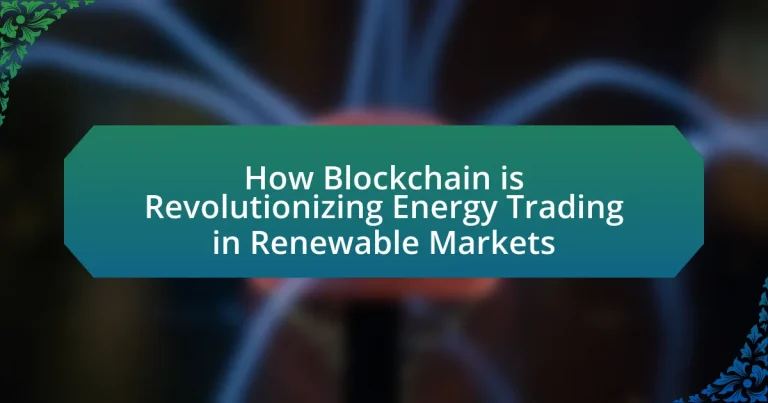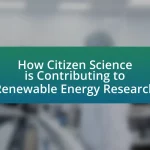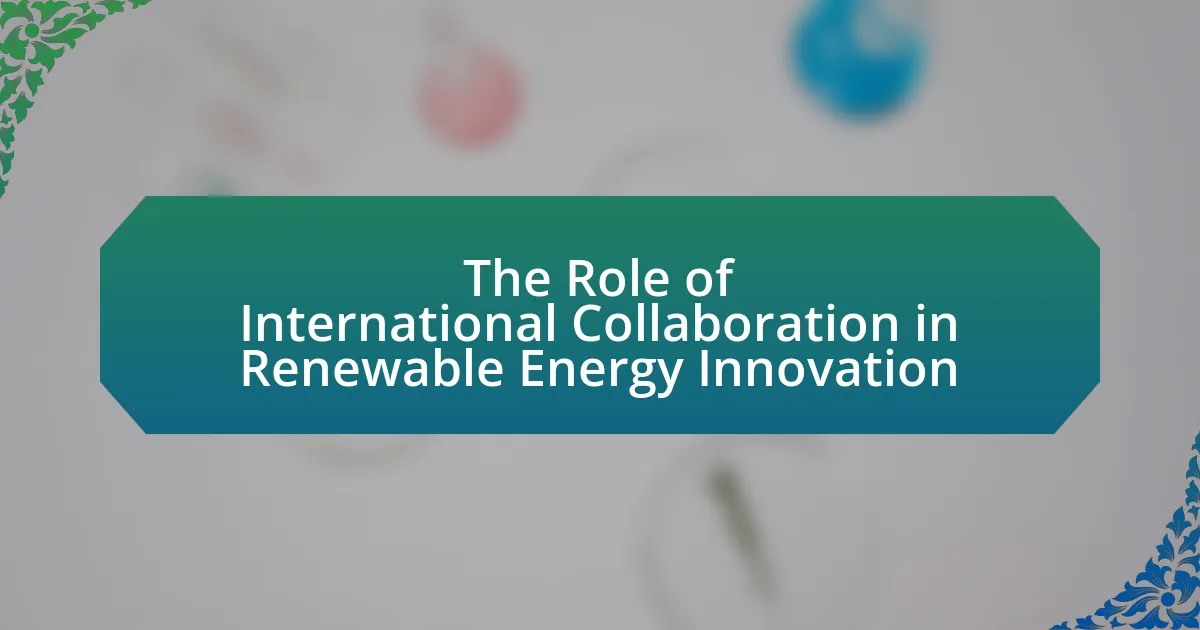Blockchain is a decentralized digital ledger technology that is transforming energy trading in renewable markets by enabling secure, transparent, and efficient peer-to-peer transactions. This technology eliminates intermediaries, reduces transaction costs, and enhances trust among participants through immutable records and smart contracts. Key features of blockchain, such as decentralization and transparency, address challenges in traditional energy trading, including inefficiencies and lack of visibility. Current applications include platforms for peer-to-peer energy trading and decentralized marketplaces, which facilitate direct transactions between consumers and producers. The article also explores future trends, potential barriers, and best practices for implementing blockchain in energy trading, highlighting its role in promoting sustainability and efficiency in the renewable energy sector.
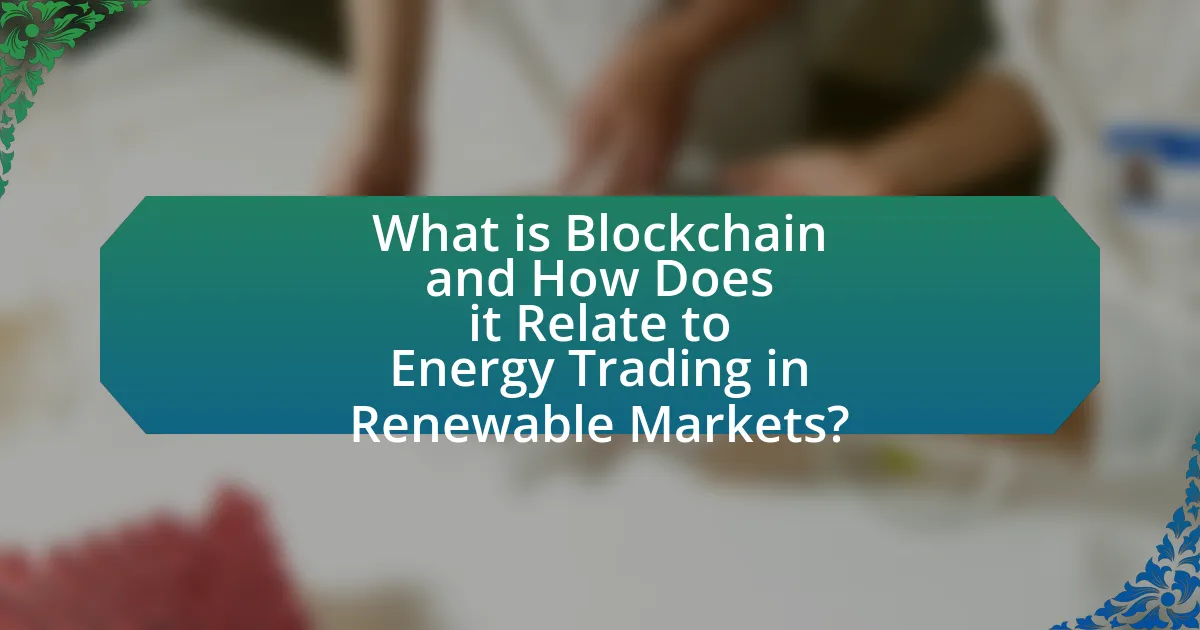
What is Blockchain and How Does it Relate to Energy Trading in Renewable Markets?
Blockchain is a decentralized digital ledger technology that securely records transactions across multiple computers, ensuring that the recorded data cannot be altered retroactively. In the context of energy trading in renewable markets, blockchain facilitates peer-to-peer energy transactions, enhances transparency, and reduces transaction costs by eliminating intermediaries. For instance, a study by the International Renewable Energy Agency (IRENA) highlights that blockchain can streamline the trading process for renewable energy certificates, making it more efficient and accessible. This technology enables real-time tracking of energy production and consumption, thereby fostering a more decentralized and resilient energy market.
How does blockchain technology function in the context of energy trading?
Blockchain technology functions in energy trading by enabling decentralized, transparent, and secure transactions between energy producers and consumers. This technology allows for peer-to-peer energy trading, where individuals can buy and sell excess energy directly without intermediaries, thus reducing costs and increasing efficiency. For instance, platforms like Power Ledger utilize blockchain to facilitate real-time energy trading, ensuring that transactions are recorded immutably and transparently. This approach not only enhances trust among participants but also supports the integration of renewable energy sources by allowing users to trade solar or wind energy directly, promoting sustainability and energy independence.
What are the key features of blockchain that enhance energy trading?
The key features of blockchain that enhance energy trading include decentralization, transparency, and smart contracts. Decentralization allows for peer-to-peer transactions without intermediaries, reducing costs and increasing efficiency. Transparency ensures that all transactions are recorded on a public ledger, which builds trust among participants and enables easier auditing. Smart contracts automate the execution of agreements based on predefined conditions, streamlining processes and minimizing the risk of disputes. These features collectively facilitate a more efficient, secure, and trustworthy energy trading environment, as evidenced by pilot projects and implementations in various renewable energy markets.
How does decentralization impact energy trading processes?
Decentralization significantly enhances energy trading processes by enabling peer-to-peer transactions without the need for intermediaries. This shift allows consumers and producers to engage directly, fostering competition and reducing costs. For instance, blockchain technology facilitates transparent and secure transactions, ensuring that energy trading is efficient and trustworthy. According to a report by the International Renewable Energy Agency (IRENA), decentralized energy systems can increase market participation and empower local communities, leading to a more resilient energy grid.
Why is blockchain considered a revolutionary technology for renewable energy markets?
Blockchain is considered a revolutionary technology for renewable energy markets because it enables decentralized energy trading, enhancing transparency and efficiency. By allowing peer-to-peer transactions without intermediaries, blockchain reduces costs and increases accessibility for consumers and producers alike. For instance, a study by the International Renewable Energy Agency (IRENA) highlights that blockchain can facilitate real-time energy trading, which can lead to a more resilient and flexible energy system. This technology also ensures secure and immutable records of energy transactions, fostering trust among participants in the renewable energy sector.
What challenges in traditional energy trading does blockchain address?
Blockchain addresses several challenges in traditional energy trading, including lack of transparency, inefficiencies in transaction processes, and high operational costs. Traditional energy trading often suffers from opaque pricing mechanisms and delayed settlement times, which blockchain mitigates through its decentralized ledger technology that provides real-time visibility into transactions. Additionally, blockchain streamlines the trading process by automating contracts via smart contracts, reducing the need for intermediaries and thus lowering costs. According to a report by the International Renewable Energy Agency, blockchain can enhance the efficiency of energy trading by up to 30%, demonstrating its potential to transform the sector.
How does blockchain improve transparency and trust in energy transactions?
Blockchain enhances transparency and trust in energy transactions by providing a decentralized and immutable ledger that records all transactions in real-time. This technology allows all participants in the energy market, including producers, consumers, and regulators, to access the same information, reducing the potential for fraud and errors. For instance, a study by the International Renewable Energy Agency (IRENA) highlights that blockchain can facilitate peer-to-peer energy trading, ensuring that all transactions are verifiable and traceable. This transparency fosters trust among stakeholders, as they can independently verify the authenticity of energy transactions without relying on a central authority.
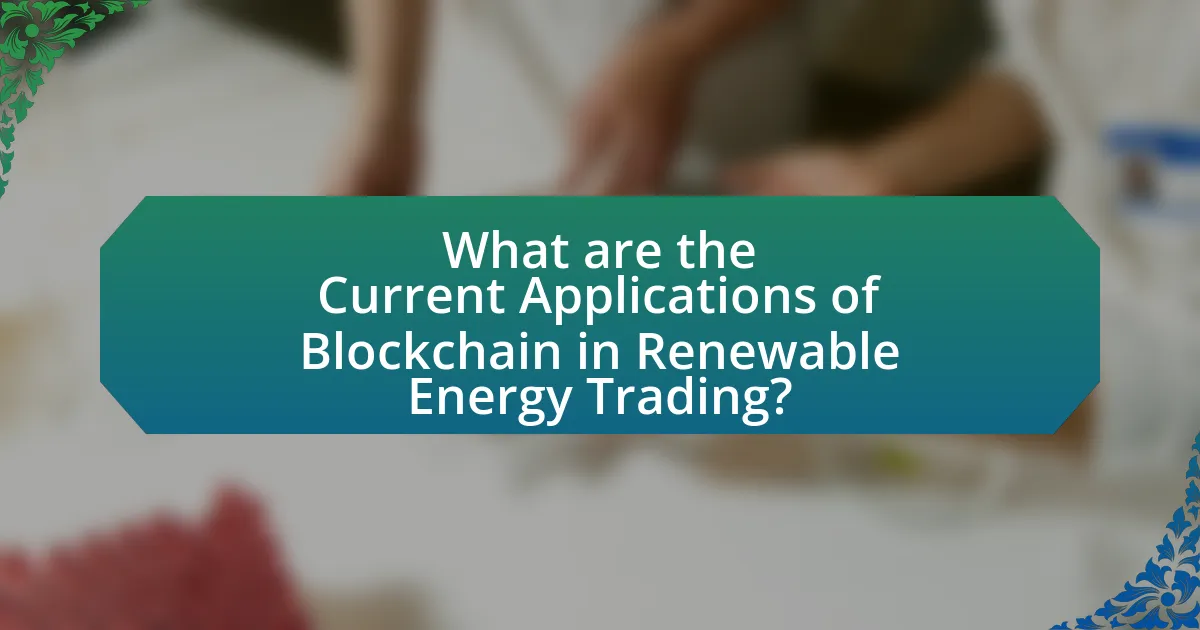
What are the Current Applications of Blockchain in Renewable Energy Trading?
Current applications of blockchain in renewable energy trading include peer-to-peer energy trading, decentralized energy marketplaces, and enhanced transparency in energy transactions. Peer-to-peer energy trading platforms, such as Power Ledger, enable consumers to buy and sell excess energy directly with one another, facilitating localized energy distribution. Decentralized marketplaces, like WePower, allow renewable energy producers to tokenize their energy, providing a more efficient way to trade energy contracts. Additionally, blockchain technology enhances transparency by providing immutable records of energy transactions, which helps to build trust among participants and streamline regulatory compliance. These applications demonstrate how blockchain is effectively transforming the renewable energy sector by increasing efficiency and reducing costs.
How are companies currently utilizing blockchain for energy trading?
Companies are currently utilizing blockchain for energy trading by enabling peer-to-peer transactions, enhancing transparency, and streamlining settlement processes. For instance, platforms like Power Ledger and LO3 Energy allow consumers to buy and sell excess renewable energy directly to one another, bypassing traditional utility companies. This decentralized approach not only reduces costs but also increases the efficiency of energy distribution. Additionally, blockchain’s immutable ledger ensures that all transactions are recorded transparently, which helps in tracking energy sources and verifying renewable energy certificates. According to a report by the International Renewable Energy Agency (IRENA), blockchain technology can significantly lower transaction costs and improve market access for renewable energy producers, thereby facilitating a more sustainable energy ecosystem.
What are some successful case studies of blockchain in renewable energy?
Some successful case studies of blockchain in renewable energy include Power Ledger in Australia, which enables peer-to-peer energy trading, allowing consumers to buy and sell excess solar energy directly. Another example is WePower, which uses blockchain to facilitate the sale of renewable energy directly from producers to consumers, streamlining the process and increasing transparency. Additionally, the Energy Web Foundation has developed a blockchain-based platform that supports decentralized energy markets, enhancing the integration of renewable energy sources. These case studies demonstrate the practical application of blockchain technology in enhancing efficiency, transparency, and accessibility in renewable energy markets.
How do peer-to-peer energy trading platforms leverage blockchain?
Peer-to-peer energy trading platforms leverage blockchain by utilizing its decentralized ledger technology to facilitate secure, transparent, and efficient transactions between energy producers and consumers. This technology enables real-time tracking of energy production and consumption, ensuring that all transactions are recorded immutably, which enhances trust among participants. For instance, platforms like Power Ledger and LO3 Energy use blockchain to automate the settlement process, allowing users to trade excess renewable energy directly with one another without the need for intermediaries. This not only reduces transaction costs but also promotes the use of renewable energy sources, as users can monetize their surplus energy.
What role do smart contracts play in blockchain-based energy trading?
Smart contracts automate and enforce agreements in blockchain-based energy trading, facilitating peer-to-peer transactions without intermediaries. They execute predefined conditions, such as energy delivery and payment terms, ensuring transparency and trust among participants. For instance, a smart contract can automatically transfer ownership of energy credits once the energy is produced and verified, streamlining the trading process. This automation reduces transaction costs and enhances efficiency, as evidenced by projects like Power Ledger, which utilizes smart contracts to enable decentralized energy trading among users.
How do smart contracts automate transactions in energy trading?
Smart contracts automate transactions in energy trading by executing predefined agreements automatically when specific conditions are met. These self-executing contracts eliminate the need for intermediaries, reducing transaction costs and increasing efficiency. For instance, when a renewable energy producer generates electricity and it meets the agreed-upon price and quantity, the smart contract automatically facilitates the transfer of ownership and payment without human intervention. This automation is supported by blockchain technology, which ensures transparency and security in the transaction process, as all parties can verify the contract’s execution in real-time.
What are the benefits of using smart contracts in renewable energy markets?
Smart contracts in renewable energy markets enhance efficiency, transparency, and trust in transactions. They automate processes such as energy trading, allowing for real-time settlements and reducing the need for intermediaries, which can lower transaction costs. According to a report by the International Renewable Energy Agency, the integration of smart contracts can lead to a 30% reduction in operational costs for energy providers. Additionally, smart contracts ensure that all parties adhere to agreed terms, minimizing disputes and fostering a more reliable trading environment. This increased reliability can attract more participants to the market, further driving innovation and investment in renewable energy solutions.

What Future Trends Can We Expect in Blockchain and Renewable Energy Trading?
Future trends in blockchain and renewable energy trading include increased decentralization, enhanced transparency, and the integration of smart contracts. Decentralization allows for peer-to-peer energy trading, enabling consumers to buy and sell energy directly without intermediaries, which can reduce costs and increase efficiency. Enhanced transparency through blockchain technology ensures that all transactions are recorded immutably, fostering trust among participants in the energy market. The integration of smart contracts automates transactions based on predefined conditions, streamlining processes and reducing the need for manual intervention. According to a report by the International Renewable Energy Agency (IRENA), blockchain could facilitate a more flexible and resilient energy system, supporting the transition to renewable energy sources.
How might blockchain technology evolve in the energy sector?
Blockchain technology is likely to evolve in the energy sector by enhancing transparency, enabling peer-to-peer energy trading, and improving grid management. As energy markets shift towards decentralization, blockchain can facilitate direct transactions between consumers and producers, reducing reliance on intermediaries. For instance, projects like Power Ledger and LO3 Energy have demonstrated successful implementations of blockchain for local energy trading, allowing users to buy and sell excess renewable energy directly. Additionally, blockchain’s immutable ledger can streamline the tracking of energy production and consumption, ensuring accurate billing and reducing fraud. This evolution is supported by the increasing adoption of renewable energy sources, which necessitate more efficient and transparent trading mechanisms.
What innovations are on the horizon for blockchain in renewable energy?
Innovations on the horizon for blockchain in renewable energy include enhanced peer-to-peer energy trading platforms, improved energy tracking and certification systems, and the integration of smart contracts for automated transactions. These advancements aim to increase efficiency and transparency in energy markets. For instance, platforms like Power Ledger are already demonstrating how blockchain can facilitate decentralized energy trading, allowing consumers to buy and sell excess energy directly. Additionally, blockchain technology can provide immutable records for renewable energy certificates, ensuring authenticity and reducing fraud. According to a report by the International Renewable Energy Agency (IRENA), blockchain could significantly lower transaction costs and enhance market access for renewable energy producers.
How could regulatory changes impact the adoption of blockchain in energy trading?
Regulatory changes could significantly accelerate or hinder the adoption of blockchain in energy trading by establishing clear legal frameworks and compliance requirements. For instance, supportive regulations can facilitate the integration of blockchain technology by providing guidelines for data privacy, transaction validation, and smart contracts, which are essential for secure and efficient energy trading. Conversely, stringent regulations or a lack of clarity can create barriers, deterring investment and innovation in blockchain solutions. Historical examples, such as the European Union’s Clean Energy for All Europeans package, demonstrate how regulatory frameworks can promote renewable energy technologies, including blockchain, by incentivizing decentralized energy markets and peer-to-peer trading.
What are the potential barriers to widespread blockchain adoption in energy trading?
The potential barriers to widespread blockchain adoption in energy trading include regulatory uncertainty, scalability issues, and integration challenges with existing systems. Regulatory uncertainty arises from the lack of clear guidelines governing blockchain technology in energy markets, which can hinder investment and innovation. Scalability issues are significant because many blockchain networks struggle to handle the high transaction volumes typical in energy trading, potentially leading to delays and increased costs. Integration challenges occur as existing energy trading systems may not easily accommodate blockchain solutions, requiring substantial changes to infrastructure and processes. These barriers collectively impede the seamless implementation of blockchain in energy trading, limiting its potential benefits.
What technological challenges must be overcome for blockchain integration?
Blockchain integration faces several technological challenges that must be addressed for effective implementation in energy trading. Scalability is a primary concern, as existing blockchain networks often struggle to handle the high transaction volumes typical in energy markets. For instance, Ethereum can process approximately 30 transactions per second, which is insufficient for large-scale applications. Interoperability is another significant challenge, as different blockchain platforms may not communicate effectively, hindering seamless data exchange across systems. Additionally, energy trading requires real-time data processing, which many blockchain solutions currently cannot provide due to latency issues. Security vulnerabilities also pose risks, as blockchain systems can be susceptible to attacks if not properly secured. Addressing these challenges is crucial for the successful integration of blockchain technology in renewable energy trading markets.
How can stakeholders address concerns related to security and scalability?
Stakeholders can address concerns related to security and scalability by implementing robust encryption protocols and utilizing decentralized architectures. For instance, employing advanced cryptographic techniques ensures that data integrity and confidentiality are maintained, which is crucial in energy trading where sensitive transaction information is involved. Additionally, adopting a scalable blockchain framework, such as Ethereum 2.0, allows for increased transaction throughput and reduced latency, addressing scalability issues effectively. Research indicates that decentralized systems can enhance security by eliminating single points of failure, thereby making the network more resilient against attacks.
What best practices should companies follow when implementing blockchain in energy trading?
Companies should prioritize interoperability, security, and regulatory compliance when implementing blockchain in energy trading. Interoperability ensures that different blockchain systems can communicate effectively, facilitating seamless transactions across platforms. Security measures, such as robust encryption and access controls, protect sensitive data and maintain trust among participants. Regulatory compliance is crucial, as energy markets are heavily regulated; adhering to legal frameworks helps avoid penalties and fosters industry acceptance. For instance, the International Energy Agency emphasizes the importance of aligning blockchain initiatives with existing regulations to ensure sustainable growth in energy trading.
How can organizations ensure compliance with regulations while using blockchain?
Organizations can ensure compliance with regulations while using blockchain by implementing robust governance frameworks that align blockchain operations with legal requirements. This involves conducting thorough regulatory assessments to identify applicable laws, such as data protection and financial regulations, and integrating compliance mechanisms directly into the blockchain architecture. For instance, smart contracts can be programmed to enforce compliance automatically, ensuring that transactions adhere to regulatory standards. Additionally, organizations can engage with regulatory bodies to stay updated on evolving regulations and participate in industry collaborations that promote best practices. This proactive approach not only mitigates legal risks but also fosters trust among stakeholders in the renewable energy market.
What strategies can enhance collaboration among stakeholders in blockchain projects?
To enhance collaboration among stakeholders in blockchain projects, establishing clear communication channels is essential. Effective communication fosters transparency and trust, which are critical in blockchain environments where multiple parties are involved. Implementing regular stakeholder meetings and utilizing collaborative tools like shared digital platforms can facilitate ongoing dialogue and information sharing. Additionally, creating standardized protocols for data sharing and decision-making can streamline processes and reduce misunderstandings. Research indicates that projects with defined governance structures and stakeholder engagement strategies are more likely to succeed, as they align interests and clarify roles among participants.
